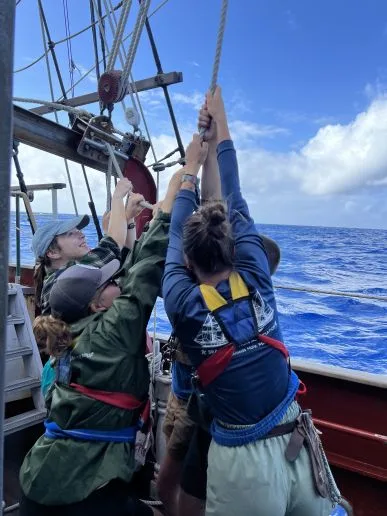Programs Blog
Charismatic Megafauna at the Bow

Nora Jackson, B Watch
Ship’s Log
Noon Position
13° 48.9’N x 152° 26.3’W
Ship Heading
340°
Ship Speed
6.1 knots
Taffrail Log
2638 nautical miles
Weather / Wind / Sail Plan
Winds ENE force 5, seas NE averaging 6 ft, 6/8 cloud cover, 26.5° C, sailing under the four lowers with a deep reef in the main
Description of location
Central North Pacific Ocean
When I last sat down to write the blog, the green tinged hills of Nuku Hiva ringed the horizon and I was eagerly waiting for the 1600 swim call off the ship into Taiohae Bay. What a contrast to today: ocean in all directions, gusty winds pulling at the laundry line, and overcast skies from horizon to horizon. The highlight of the day might be sighting pilot whales (or possibly melon head whales?) off the starboard bow. Just as I was about to start typing this entry the call went up! Sure enough, we were in the company of 6-7 pilot whales gracefully surfing the swells colliding with the hull. With ease, they jumped out of the water, zoomed by beneath us, turquoise water spilling off their flukes, and wove among each other without a single wasted motion. What a reminder of our own awkwardness in the ocean. As much as any one of us feels a calling to the ocean or seaside, open water sailing provides constant reminders of our own out-of-placeness.
The water is our constant neighbor here, always just beyond the railing. These days, the water is an even closer neighbor. Since crossing the equator, the seas have gotten larger and the days when we had to motorsail to make any headway feel very long ago. The air is full of rich salt spray such that my glasses are constantly smudged and clothes on the laundry line rarely reach a state passed damp. The ocean itself sloshes through the port scuppers as we careen over particularly large swells with a sound like a fast river rapid. Unlike the pilot whales, without the Robert C. Seamans, we would flounder. One of the things that draws me to sailing is the self-sufficiency of life and work onboard, but whatever competency I might feel at sea will never replace the deep respect and humility I feel from watching the ocean day after day.
In other ways, we happily let seawater into our lives. Our science lab relies on seawater flowing past various sensors to tell us about sea surface temperature, chlorophyll-a, and salinity. We take salt water showers on deck and use salt water in our laundry, at least in the first bucket. Through reverse osmosis we distill salt water into fresh water which courses through the ship into faucets and taps. Life on a ship not only means staying out of reach of the rising swells just beyond the waist-high railing, but also accepting the water all around us. Even secluded in the laboratory, the swells and motion of the sea remind us of where we are. The movement of water, both around us and many hundreds of miles away, contributes to the weather we experience. When squalls blot out the horizon and the ocean turns steely grey, we don foulie gear (rain jackets) and work in the rain. The 5.4 kilometers of water below us creates the scientific phenomena we are here to study and houses the creatures we collect and marvel over. Nowhere else am I so keenly aware of water and all of its properties. The tug and push of currents affects our speed, our course, and our path over the swells sometimes allowing for gentle rocking at other times creating harsh, erratic rolls that knock things off of counters. At such times, I’m grateful for gimbaled tables that keep our food and plates in place, for drawers that latch, and for laughter as we all stumble around below decks trying to stay upright. Nora Jackson, B Watch
Recent Posts from the Ships
- Ocean Classroom 2024-A collaborative high school program with Proctor Academy
- Collaborations and Long-term Commitments: SEA’s Caribbean Reef Program Sets a Course for Coastal Programs that Compliment Shipboard Experiences.
- Sea Education Association students prepare for life underway using state of the art nautical simulation from Wartsila Corporation.
- SEA Writer 2022, Magazines From the Summer SEA Quest Students
- Technology@SEA: Upgrades Allow Insight into Ocean Depths
Programs
- Gap Year
- Ocean Exploration
- High School
- Science at SEA
- SEA Expedition
- SEAScape
- Pre-College
- Proctor Ocean Classroom
- Protecting the Phoenix Islands
- SPICE
- Stanford@SEA
- Undergraduate
- Climate and Society
- Climate Change and Coastal Resilience
- Coral Reef Conservation
- Marine Biodiversity and Conservation
- MBL
- Ocean Exploration: Plastics
- Ocean Policy: Marine Protected Areas
- Oceans and Climate
- Pacific Reef Expedition
- The Global Ocean: Hawai'i
- The Global Ocean: New Zealand